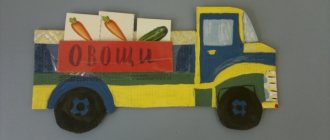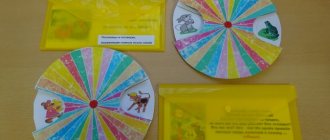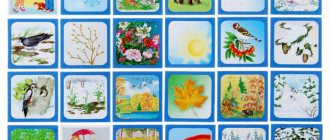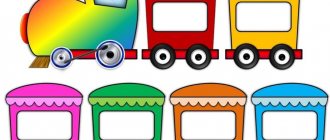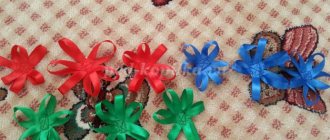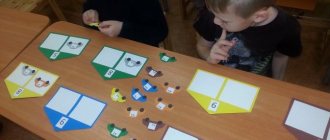Didactic game “You can - you can’t, right - wrong.”
Goals: To form in children ideas and a responsible attitude towards what is and is not possible on the street, road and in transport.
Materials for the game: Cards with correct and incorrect behavior of children (situations) on the road, on the street and in transport (bus and subway.) Cards with a smiling sun and a sad sun for each player.
Progress of the game:
I option. All children take part in the game. The teacher gives the children cards with a smiling sun and a sad sun. Consistently shows cards with various situations of children’s behavior on the street, road, and in transport. Children raise the card with the sun that corresponds to the given situation, i.e. you can behave this way in transport or on the street (smiling sun) or not (sad sun), whether the children act correctly or not. The one who not only raises correctly wins corresponding card, but will also explain why he picked it up.
Option II . No more than six children take part in the game. The teacher distributes cards with situations to the children, 4 cards to each child. Children lay them out in front of them. Cards with suns are placed in the middle of the table. Children look at their cards, take the sun and put it on the card with the situation corresponding to the expression (happy or sad sun). The winner is the one who is the first to cover all situations with cards with suns and tell why he covered this picture with a happy or sad sun.
Didactic game "Road signs for pedestrians."
Objectives: To consolidate knowledge and purpose of road signs.
Materials for the game: Signs “Pedestrian crossing”, “Pedestrian traffic is prohibited”, “Underground pedestrian crossing”, “Overground pedestrian crossing”, “First aid station”, “Slippery road”, “Bicycle path”, “Bicycle traffic is prohibited” ", "Road works", "Railway crossing without a barrier", "Dangerous turn", "Rough road". 4-5 signs per child.
Progress of the game . The whole group or several children take part in the game. The teacher gives the children 4-5 road signs. Children lay them out in front of them. The teacher reads out the rule for pedestrian behavior on the road, and the child shows the corresponding road sign and explains its purpose and importance for the pedestrian. The winner is the one who correctly shows all the road signs and talks about the purpose of this or that road sign for a pedestrian.
Didactic Lotto game “Learn to be a pedestrian.”
Goals: Continue to introduce children to the rules of safe behavior on the street. Strengthen knowledge of road signs necessary for pedestrians. Materials for the game: Large cards, with various situations on the roads (according to the rules of behavior of children on the road, on the street and in transport). There are six situations on each card. Small cards with road signs and traffic rules on the back and white cards crossed out diagonally.
Progress of the game . No more than six children take part in the game. The teacher distributes large cards to the children (one card to one child). Shows a card with a road sign and reads the rules of conduct on the road or in transport. The child looks at the card, finds the appropriate situation and puts a small card with a road sign or a white card on it (if the situation indicates the child’s incorrect behavior on the road or in transport). The first one to cover all six situations on his card wins. Didactic games for developing thinking and attention
Card index of didactic life safety lessons for older preschoolers
Equipment:
pictures depicting animals in a period of rest and in a period of aggression, cards in red and green colors.
Game participants:
teacher and children in the amount of 2 people.
Description:
Look carefully at the pictures (models of animals), put a green card on the picture that shows an animal that you can now approach (rest period). And a red card goes to a picture of an animal during a period of aggression (you cannot approach). The one who completes the task correctly and first wins.
2.
“Ambulance” (story-based role-playing game)
Purpose:
strengthening children's knowledge and practical skills in first aid.
Equipment:
pictures, medical supplies (thermometer, syringe, cotton wool, etc.)
Game participants:
teacher and children in the amount of 4 people.
Description:
The teacher plays out with the children a situation where a person has cut his arm, leg, broken his knee, elbow, has a fever, has a sore throat, has a speck of dirt in his eye, and has a nose bleed. For each situation, a sequence of actions is worked out.
3."When danger threatens"
Target:
consolidating children's knowledge of necessary actions in case of danger.
Equipment:
pictures depicting actions dangerous to a child, telephone.
Game participants:
teacher and children in the amount of 2 people.
Description:
children receive a picture, name a dangerous situation and dial the required phone number, give their name, address, and say what happened.
4.
“What would you do”
Purpose:
strengthening the ability to make the right decisions in various life situations, to control one’s behavior when communicating with people.
Equipment:
story pictures on the problem, prizes.
Game participants:
teacher and children in the amount of 4 - 6 people.
Description:
players consider illustrated typical dangerous situations of possible contacts with strangers on the street:
Ø an unfamiliar adult persuades the child to go somewhere with him, promising to show him something interesting, offering a toy;
Ø an unfamiliar adult opens the car door and invites you to ride with him;
Ø an unfamiliar adult treats you to candy, ice cream, etc.
For each correctly made decision, the player receives a chip.
5.
“Telephone”
Purpose:
developing knowledge about telephone communications as an essential item in critical situations, introducing the telephone numbers of rescue services.
Equipment:
illustrations depicting a particular dangerous situation, game vehicles of rescue services, cards with telephone numbers.
Game participants:
teacher and children in the amount of 2 people.
Description:
match the illustration with a specific situation to a telephone number or a vehicle of a specific rescue service.
6.
“Let’s make a model of a good and an evil person”
Goal:
developing the ability to select details of a person’s face who may pose a danger (and vice versa) to others.
Equipment:
facial details (eyes with different facial expressions, noses, mouths of different shapes, different hairstyle details), facial contours.
Game participants:
teacher and children in the amount of 2 people.
Description:
invite children to use individual details to create an imaginary face corresponding to the appearance of a good and evil person.
7.
“Our helpers plants”
Purpose:
to strengthen children's ideas about how to help themselves and others always stay healthy.
Equipment
: subject pictures depicting medicinal plants.
Description:
The game is played on the lotto principle. Children have cards with images of medicinal plants. The teacher shows pictures with similar drawings. A child who has this plant talks about its use for healing. If he said it correctly, he gets a picture. The one who closes his card first wins.
8.
“Familiar, friend, stranger”
Purpose:
formation of a precise concept of who is “us”, “stranger”,
"acquaintances".
Equipment:
ball.
Game participants:
teacher and group of children.
Description:
Before starting the game, find out from the children who, in their opinion, can be considered “their own”, and who can be considered a “stranger”, “familiar”. Ask how an acquaintance is different from a close person than from a stranger, an outsider. Children stand at a short distance from each other, forming a circle. The presenter, in the center, throws the ball to everyone in turn, saying: familiar, friendly, alien, highlighting with intonation and pause the one who needs to be named. The child who catches the ball names the appropriate person and returns the ball to the leader.
9.
“Choose edible mushrooms and berries”
Goal:
consolidation of knowledge about edible and poisonous plants, the ability to distinguish them from each other.
Equipment:
baskets, dummies or cards depicting edible and poisonous mushrooms and berries, chips.
Game participants:
teacher and children in the amount of 2 people.
Description:
offer to collect edible mushrooms and berries in baskets, and leave the “inedible” ones in the forest. For each correctly chosen plant, a chip. The player with the most chips wins.
10.
“What do we know about things”
Purpose:
expand children’s understanding of the rules of safe behavior at home; develop attention and memory; foster a sense of cooperation.
Equipment:
four game cards depicting a cut, burn, hand bruise and fire; pictures depicting various household items.
Game participants:
teacher and children in the amount of 2 people.
Description:
4 children take part in the game, each of them takes a game card with the image of an “injury”. The teacher (child) is the leader. He picks up a picture of an object one by one. Participants must guess what injury could result from improper handling of this item, match it to their card and take the picture. When selecting, the child must explain why this or that object is dangerous and tell the rules for handling it.
11.
“We are drivers” (story-based role-playing game)
Purpose:
teach children to recognize road signs:
ü warning
— “Children”, “Pedestrian crossing”, “Wild animals”;
ü prohibiting
— “Entry is prohibited”, “Traffic is prohibited”, “Bicycles are prohibited”;
ü prescriptive
— “Move straight”, “Move right”, “Move left”, “Circular traffic”, “Pedestrian path”;
ü information and guidance
— “Parking area”, “Pedestrian crossing”;
ü service marks
— “First aid station”, “Telephone”, “Food station”, “Gas station”, “Car maintenance”, “Rest place”, “Traffic police post”); develop attention and spatial orientation skills.
Equipment
: road signs, attributes for s/r games (cars, cape and cap of a traffic police inspector, baton, rug - imitation of a road with a pedestrian crossing and intersection.
Game participants:
teacher and group of children.
Description:
children are invited to consider the attributes for the game, place road signs, assign roles, create a game situation and play it out
12.
Game “Collect a dangerous object”
Goal:
Improve children's ability to assemble parts into a whole. Reinforce knowledge about dangerous objects and rules for handling them.
Equipment:
cut-out pictures of dangerous objects.
Game participants:
teacher and children in the amount of 2 people.
Game actions:
assemble a dangerous object from parts, tell the rules for safe handling of it.
13.
Game “Security Chain”
Purpose:
Review safety rules.
Equipment:
chips for each child.
Description:
Any number of children take part in the game; they need to answer a question, for example: What causes of fires do you know? Each child in turn must give his or her reason. For the correct answer, the child is given a chip; the one who gets the most chips wins.
Sample
questions:
How can a fire be prevented? What should you do if there is a fire in your apartment? State the rules for handling electrical appliances. Name a dangerous object and explain why it is dangerous. Etc.
14.
Game “Fourth wheel”
Purpose:
Learn to identify dangerous objects among objects and explain the rules for safe handling of them. Develop attention and logical thinking.
Material:
a set of cards depicting various objects.
Description:
choose among the objects depicted - dangerous and explain your choice.
15.
Game “Invite Bear to visit.”
Target:
consolidate knowledge of home address, teach the rules of inviting guests.
Equipment:
houses built by children from building materials or construction sets, teddy bear toy.
Game participants:
teacher and children in the amount of 4 - 6 people.
Description:
Each child chooses a home for themselves, politely invites Teddy Bear to visit them, telling him their home address.
16.
Game “Dangerous Objects”
Purpose:
consolidate ideas about the sources of danger in the house, develop intelligence and attention.
Equipment:
pictures of household items.
Game actions:
choose from the proposed pictures those that depict sources of danger, explain your choice.
17.
Game “Edible - Inedible”
.
Target:
consolidate the idea of edible and inedible mushrooms (berries)
Equipment:
ball.
Description:
The teacher throws the ball to the child. If the mushroom (berry) is edible, if not, the child hits the ball.
18.
Game “Good - bad”. (Word game)
Purpose:
Learn to see an object in its various manifestations, develop logical thinking.
Description:
The teacher offers any object (fire, scissors, axe, water, etc.) the child must find its good and bad sides.
19.
Game “Right - Wrong”
Purpose:
to form children's understanding and responsible attitude towards the rules of behavior on the road, in public transport and on the street.
Equipment:
layout of a clock with arrows (red and green) and pictures with correct and incorrect behavior on the street, transport, road.
Game participants:
teacher and children in the amount of 2 people.
Description:
The teacher invites the child to look at the pictures and tells them that the red arrow points to a picture with incorrect behavior, and the green arrow points to a picture with correct behavior. The child selects a picture, selects the corresponding color arrow, tells what it shows, and finds the opposite picture, also explaining his choice. Passes the turn to another child. The one who completes the task correctly wins.
1.
Didactic game “Fishing - Alphabet”
Purpose: to form children’s ideas about the sounds and letters of the alphabet.
Equipment:
a box depicting a pond, a fishing rod, pictures of fish depicting letters of the alphabet.
Game participants:
teacher and children in the amount of 2 people.
Game description:
invite the child to look at the fish with letters and use a fishing rod to catch the fish and name the letter. The one who catches the most fish and names the letters correctly wins.
2.
Didactic game “Speech collage Autumn”
Purpose:
consolidate children's knowledge about the signs of autumn, teach them to find words, objects and action words, develop classification and generalization skills, develop visual attention and logical thinking.
Equipment:
speech collage panel on the theme “Autumn”.
Game participants:
teacher and children in the amount of 2 people.
Game description:
invite children to look at the collage and find and name pictures depicting signs of autumn, words objects answering the question what?, who?, action words answering the question what is he doing, what are they doing?, pictures depicting only vegetables (fruits), (berries ), name them in one word, the words are objects that are only red (yellow, green). For each correct answer, the child receives a chip. The one who collects the most chips wins.
3. Didactic game “Fruit juice”
I
version of the game.
Target:
teach children to form from noun. words signs in units number.
Equipment:
didactic manual “Sun”.
Game participants:
teacher and children in the amount of 2 people.
Description:
In the middle of the sun, the teacher places a picture of a child drinking juice. Asks the children to place pictures of fruits on the rays of the sun and name them. The teacher gives a verbal sample and asks the children to reproduce the verbal sample one by one, replacing it with the name of another fruit.
For example, This is an orange. I drink orange juice.
II
version of the game.
Target:
teach children to change verbs according to persons in the present tense.
I drink orange juice. You drink orange juice. We drink orange juice.
4 Didactic game "Fourth odd"
III
Option
Goal:
teach children classification and generalization.
Equipment:
cards with vegetables and fruits, teaching aid (side with pockets).
Game participants:
teacher and children in the amount of 2 - 4 people.
Description:
4 cards with three fruits and a vegetable are inserted into the pockets of the teaching aid. Children are asked to think and name the extra object.
The one who completes the task correctly wins.
5. Didactic game “Tops and Roots”
Target:
consolidate children's knowledge about root crops and vegetables growing on bushes above the ground, on the ground.
Equipment:
teaching aid (side with pockets), cards with pictures of vegetables.
Game participants:
teacher and children in the amount of 2 people.
Description: children arrange the cards according to the schematic drawings. The one who completes the tasks correctly wins.
6. Didactic game “Find your home”
Target:
Give children an idea of the habitat and home of wild animals and birds.
Equipment:
teaching aid (side with pockets) or cassette boxes, cards with images of wild animals, birds and their homes.
Game participants:
teacher and children in the amount of 2 people.
Description:
The teacher invites the child to look at the pictures in his pockets, arrange them and name the dwelling in which the animal or bird lives. The one who completes the task correctly wins.
7. Didactic game “Fruits, vegetables and berries”
Target:
teach children the classification and generalization of fruits, berries, and vegetables.
Equipment:
game cards with images of baskets with empty cells, cards with images of vegetables and fruits, berries.
Game participants:
teacher and children in the amount of 3 people.
Description:
The teacher divides the pictures between the children and, according to the principle of playing lotto, the children fill in the empty cells on the baskets. The one who completes the task correctly wins.
8. Didactic game “Colored Carousel”
Target:
development of fine motor skills of the hands, attention, perseverance, concentration, creativity, consolidation of color spectrums.
Equipment:
teaching aid: part of a plastic bottle with cut strips and cocktail tubes.
Description:
Children are asked to string parts of tubes onto strips in a given color order. Then the children themselves choose the color of the tubes and the order.
9. Didactic games for the development of speech breathing “Fruitball” “Football”, “Autumn Tree”
Target:
develop speech breathing in children.
Equipment:
a foil tree with multi-colored leaves, a playing field with folds and a light ball, a fruit gate, cocktail straws.
Participants:
teacher and children in the amount of 2-4 people.
Description:
Children take turns blowing the ball into the gate and blowing on the leaves of the trees. The one who completes the task correctly wins.
10. Didactic game “Magic Ball”
Target:
teach children to massage their hands using a ball with soft spikes.
Equipment:
balls with soft spikes, cones.
Game participants:
teacher and children in the amount of 4 people.
Description:
Children perform movements according to the teacher’s model and independently.
11. Didactic game “From which tree did the leaf fall”
Target:
consolidate knowledge about the names of trees, learn to form words signs from nouns.
Equipment:
cards with images of trees and leaves, teaching aid with pockets.
Game participants:
teacher and children in the amount of 2 people.
Description:
invite the children to name which tree the leaf fell from and choose the word sign for it. The one who completes the task correctly wins.
12. Didactic game “Let’s go to the forest to pick mushrooms”
Target:
Give children an idea of edible and inedible mushrooms.
Equipment:
cards with images of edible and inedible mushrooms, teaching aid with pockets.
Game participants:
teacher and children in the amount of 2 people.
Description:
invite the children to arrange the cards in accordance with the diagrams of mushrooms into edible and inedible. The one who completes the task correctly wins.
13. Didactic game “Collect a chain”
Target:
develop children's fine motor skills of the hand, attention, and consolidate knowledge about colors.
Equipment:
strips of fabric napkins with sewn buttons and loops.
Game participants:
teacher and children in the amount of 2 people.
Description:
Children are asked to make a chain out of fabric strips by fastening buttons. The one who makes the longest chain wins.
14. Didactic game “Assemble a pattern”
Target:
develop children's fine motor skills of the hand, attention, and consolidate knowledge about colors.
Equipment:
various figures made of cellulose.
Game participants:
teacher and children in the amount of 2 people.
Description:
Children are invited to build various combinations of plots and figures from the figures. The one who made the most figures and plots wins.
15. Didactic game “Magic Delays”
Target:
develop children's fine motor skills of the hand, attention, and consolidate knowledge about colors.
Equipment:
soft fluffy wires.
Game participants:
teacher and children in the amount of 2 people.
Description:
Children are invited to build various combinations of plots and figures from wires. The one who made the most figures and plots wins.
16. Didactic game “Fold a letter from tubes”
Target:
develop children's fine motor skills of the hand, attention, and consolidate knowledge about colors.
Equipment:
cardboard plates with plasticine, stacks, and cut-out tubes applied to the surface.
Game participants:
teacher and children in the amount of 2 people.
Description:
The teacher draws a letter (number, geometric figure) in a stack and invites the children to lay out the drawn outline using tubes. The one who completes the task correctly and accurately wins.
17. Didactic game “Finger Theater”
Target:
develop children's fine motor skills of the hand, attention, and develop coherent speech.
Equipment:
knitted finger theater.
Game participants:
teacher and children in the amount of 2 people.
Description:
The teacher invites children to use a finger theater to tell their favorite fairy tale, using various movements of the fingers. The one who told the fairy tale more interestingly wins.
18. Didactic game “Domestic and wild animals”
Target:
consolidate knowledge about wild and domestic animals, teach classification and generalization.
Equipment:
teaching aid (side with pockets), subject cards with images of wild and domestic animals.
Participants of the game:
teacher and children in the amount of 2 people.
Description:
The teacher invites the child to look at pictures depicting domestic and wild animals and put them in pockets with a house for domestic animals, and in pockets with a spruce tree for wild animals. The one who completes the task correctly wins.
19. Didactic game “Who is missing”
Target:
consolidate knowledge about wild and domestic animals, teach how to form nouns. in the instrumental case singular. numbers.
Equipment:
teaching aid (side with pockets), subject cards with images of wild and domestic animals.
Participants of the game:
teacher and children in the amount of 2 people.
Description:
The teacher invites the child to look at pictures depicting domestic and wild animals and remember them. Then the teacher asks the children to close their eyes. Removes any picture and asks the child to name which picture is missing. The one who completes the task correctly wins.
Card index of games for economic education of preschoolers
Content. Children look at the cards, name the activities of the adults, the result obtained, and highlight the main and additional incomes.
"Freight train"
Goal: To consolidate children’s knowledge about the place of manufacture of goods; classify goods by place of production.
Material: Cards with the image of the product, a flat image of a freight train with wagons.
Contents: Children lay out goods among the carriages so that each contains goods that are identical at the place of production. For example, meat products are products of a meat processing plant, dairy products are products of a dairy plant, etc.
Option. Children group objects by place of production: furniture - furniture factory, dishes - earthenware factory, toys - toy factory, etc.
"Product routes"
Goal: To develop in children the ability to distinguish goods according to their belonging to a certain group (household appliances, industrial goods, furniture, agricultural products, etc.)
Material: Pictures depicting goods or real objects and toys, signs with the name of stores: “Clothing”, “Furniture”, “Household appliances”, “Agricultural products”, etc.
Content. Each child chooses a picture card, names what is drawn on it, and determines which store this product can be taken to. The winner is the one who correctly matches the cards to the signs with the name of the store.
"Put it together"
Target. Expand children's understanding of products; teach how to group them according to different characteristics.
Material. Map (panel) depicting various products.
Content. Each child has a card with different objects drawn on it. Using Euler-Venn circles (diagrams), children combine objects according to various criteria: edible - inedible; toys - tools; goods that are mandatory for everyone are optional, etc.
"Guess where they sell"
Target. Teach children to correlate the name of the store with the goods that are sold in it; develop the ability to generalize groups of objects.
Material. Pictures depicting vegetables, fruits, furniture, shoes, etc.
Content. Children select groups of cards with images of vegetables, fruits, furniture, etc. Lay them out in front of the corresponding plot picture, where the stores “Furniture”, “Vegetables”, “Supermarket”, etc. are drawn. Establish a relationship between the name of the store and the goods that are in they are sold there.
"A toy shop"
Target. Give children the opportunity to practically carry out the buying and selling process; develop the ability to “see” a product: material, place of production, price (cost).
Material. Various toys, price tags, trademarks, play money.
Content. Before buying a toy he likes, the child names the material from which it is made (wood, metal, plastic, fabric, paper, etc.). Place of production (where and who made it). Next, the price of the toy is determined. The child counts out a certain amount of money and buys a toy. As toys sell out, the seller adds new ones.

